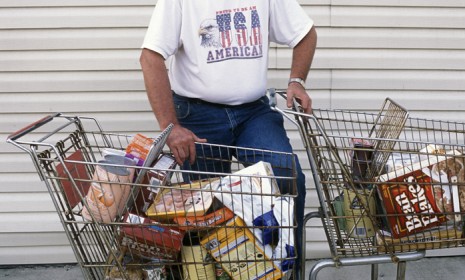Americans' growing dependency on food stamps
One in seven U.S. citizens receives aid to buy food. Are we feeding the hungry, breeding dependency, or both?

What are food stamps?
They're a form of aid provided by the federal government to low-income households to help them buy food. The term "food stamps" comes from the coupon-like stamps used during the "War on Poverty" in the 1960s, although they were phased out in 2004 in favor of plastic debit cards, which are refilled electronically each month. In 2008, the government rechristened the program Supplemental Nutrition Assistance Program, or SNAP. But most people still call it food stamps, and the program has become a political flash point since GOP presidential candidate Newt Gingrich said in January that "more people have been put on food stamps by Barack Obama than any president in American history."
Is that true?
The Week
Escape your echo chamber. Get the facts behind the news, plus analysis from multiple perspectives.

Sign up for The Week's Free Newsletters
From our morning news briefing to a weekly Good News Newsletter, get the best of The Week delivered directly to your inbox.
From our morning news briefing to a weekly Good News Newsletter, get the best of The Week delivered directly to your inbox.
There can be no dispute that the number of people added to food stamp rolls since 2008 is larger than in any previous president's term. Last year, 45 million Americans — 14 percent of the population — received food stamps; in 2008, before Obama took office, about 28 million did. But the number of recipients has risen steadily over the last decade, and actually grew by a higher percentage under the eight years of George W. Bush's administration than it has under Obama's so far. Much of the expansion came at the end of the Bush administration, during the worst economic downturn since the Great Depression.
So the recession caused the increase?
A large part of it, but there were other factors as well. Millions of people lost jobs in the last four years, and being plunged into poverty made them eligible for food assistance. "That's the way this program is designed," said Kevin Concannon, the head of the USDA's Food and Nutrition Service. Some 15 percent of the population — the highest rate since 1993 — now lives at or below the poverty level, which is defined as $19,090 per year for a family of three. The average food stamp household of 2.2 people receives $287 in monthly food-assistance benefits, or about $72 a week. That's not a lot to feed two people, but food stamp spending adds up: It has quadrupled in the course of the last 10 years, to a total this year of $80.4 billion. Critics blame that cost explosion on relaxed eligibility standards that began under the Bush administration, and on a boost in monthly benefits put through by Obama as part of the 2009 stimulus package. Obama increased the amount of time people could stay on food stamps, and added about $80 to the monthly benefits of a family of four. "No program in our government has surged out of control more dramatically than food stamps," said Sen. Jeff Sessions of Alabama. "Do you think there are four times as many people who need food stamps today as in 2001?"
Who qualifies for food stamps?
A free daily email with the biggest news stories of the day – and the best features from TheWeek.com
Three quarters of SNAP recipients are children, teenagers, senior citizens, and people with disabilities, according to Agriculture Secretary Tom Vilsack. The average recipient household has a gross income of $8,532 a year, or just $711 per month. While Gingrich has said that African-Americans "should demand paychecks and not be satisfied with food stamps," they account for just 22 percent of recipients. About 34 percent of food stamp recipients are white and 16 percent Hispanic, with the rest being Asian, Native American, and "unidentified." Four of 10 SNAP households have one family member who has a job — one with wages so low that the household still qualifies.
Is there fraud in the program?
Undoubtedly, as there is in all government aid programs. In Pennsylvania, 178 grocery and convenience stores were caught trading cash for food stamps last year, and in New York City, where recipients must be fingerprinted, officials discovered 1,900 people who were using two names to receive double benefits, saving taxpayers just over $5 million. Citing "widespread reports of fraud and abuse," Sessions has asked the USDA to shore up its "lax oversight" of the food stamp program. Somehow, he said, a Michigan man was able to keep collecting food stamps after he won a $2 million lottery jackpot, while a Washington state couple stayed on the rolls while living in a $1.2 million home. The USDA, however, argues that the amount of fraud is relatively low: In fiscal 2011, states disqualified 44,483 individuals for fraud — one tenth of 1 percent of program participants. Still, even the USDA admits that fraud costs the program an estimated $750 million a year.
Can spending be reduced?
Republicans are calling for new tests limiting benefits to the truly needy, and the idea is gaining traction: Pennsylvania Gov. Tom Corbett, for example, has proposed an "asset test" that would deny food stamps to households with assets of more than $5,500. Florida has passed a law requiring recipients to be drug tested, which is now being challenged in court. But such tweaks to the system won't significantly reduce the eligibility rolls, the overall cost, or the problem of dependence. Only an improved economy, and more jobs, will do that. And while it makes sense to limit food stamp benefits to those who truly need them, says former Bush speechwriter Michael Gerson, reformers should remember that this is one government program that has shown measurable results — "the improvement of millions of lives."
Living on food stamps
What do you eat on $4.06 a day? Las Vegas Mayor Carolyn Goodman took a local food bank's challenge to live for five days on the food stamp allowance for a single Nevadan. Breakfast was Cheerios, lunch canned soup, and dinner tuna sandwiches or macaroni and cheese. "I didn't get to put any fruit on my meal plan," Goodman said, noting that healthy food tends to be more expensive than processed food. "It's a good thing that I love tomato soup." The government does not track what people buy with food stamps, and the rules allow almost any food or food product that can be cooked or heated at home. "It's just a small help," says Josephine Gonzales, an unemployed single mother. "It's not making our lives luxurious."
-
 Antibiotic resistance: the hidden danger on Ukraine’s frontlines
Antibiotic resistance: the hidden danger on Ukraine’s frontlinesUnder The Radar Threat is spreading beyond war zones to the ‘doorstep’ of western Europe
-
 ‘Capitalism: A Global History’ by Sven Beckert and ‘American Canto’ by Olivia Nuzzi
‘Capitalism: A Global History’ by Sven Beckert and ‘American Canto’ by Olivia NuzziFeature A consummate history of capitalism and a memoir from the journalist who fell in love with RFK Jr.
-
 Who will the new limits on student loans affect?
Who will the new limits on student loans affect?The Explainer The Trump administration is imposing new limits for federal student loans starting on July 1, 2026